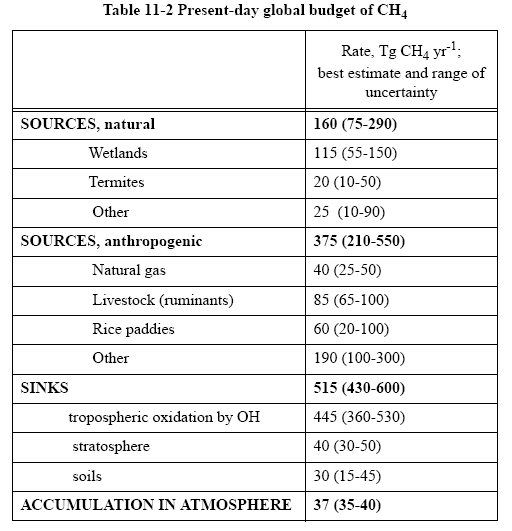
- •Основные газы тропосферы и их роль
- •Global budgets of co and methane
- •Продукция тропосферного озона
- •Co oxidation mechanism
- •Methane oxidation mechanism
- •Global budget of nitrogen oxides
- •Global budget of tropospheric ozone
- •Anthropogenic influence on ozone and oh
- •Figure. Longitudinally averaged concentrations of nOx, co, o3, and oh as a function of latitude and pressure computed with a global 3-dimensional model
- •Формирование и разрушение озона в условиях загрязненной атмосферы
- •Figure - Cycling of hOx and o3 production in a polluted atmosphere.
Global budgets of co and methane
Carbon monoxide and methane are the principal sinks for OH in most of the troposphere. These two gases play therefore a critical role in controlling OH concentrations and more generally in driving radical chemistry in the troposphere

Table gives a global budget of CO for the present-day atmosphere. Fossil fuel combustion and biomass burning (principally associated with tropical agriculture) are large anthropogenic sources, and oxidation of CH4 is another major source. Most of the CO in the present-day troposphere is anthropogenic. The main sink of CO is oxidation by OH and results in a 2-month mean lifetime; because of this relatively short lifetime, CO is not well-mixed in the troposphere. Concentrations are 50-150 ppbv in remote parts of the world, 100-300 ppbv in rural regions of the United States, and up to several ppmv in urban areas where CO is considered a hazard to human health.
Atmospheric concentrations of CH4 have increased from 800 to 1700 ppbv since preindustrial times (Figure 7-1). The reasons are not well understood. A present-day global budget for CH4 is given in Table 11-2. There are a number of anthropogenic sources, some combination of which could have accounted for the observed CH4 increase. One must also consider the possible role of changing OH
concentrations. Oxidation by OH in the troposphere provides 85% of the global CH4 sink (uptake by soils and oxidation in the stratosphere provide small additional sinks; see problem 4. 8). A decrease in OH concentrations since pre-industrial times would also have caused CH4 concentrations to increase.

Продукция тропосферного озона
![]()
![]()
![]()
In the early 1970s when the importance of OH as a tropospheric oxidant was first realized, it was thought that the O3 molecules necessary for OH production would be supplied by transport from the stratosphere. The chemical lifetime of O3 in the lower stratosphere is several years, sufficiently long to allow transport of O3 to the troposphere. The transport rate F of O3 across the tropopause is estimated to be in the range 1-2x1013 moles yr-1. One can make a simple argument that this supply of O3 from the stratosphere is in fact far from sufficient to maintain tropospheric OH levels. Each O3 molecule crossing the tropopause can yield at most two OH molecules in the troposphere by reactions (R1)+(R3) (some of the O3 is consumed by other reactions in the troposphere, and some is deposited at the Earth’s surface). The resulting maximum source of OH is 2F = 2-4x1013 moles yr-1. In comparison, the global source of CO to the atmosphere is 6-10x1013 moles yr-1 (Table 11-1) and the global source of CH4 is about 3x1013 moles yr-1 (Table 11-2). There are therefore more molecules of CO and CH4 emitted to the atmosphere each year than can be oxidized by OH molecules originating from O3 transported across the tropopause. In the absence of additional sources OH would be titrated; CO, CH4, HCFCs, and other gases would accumulate to very high levels in the troposphere, with catastrophic environmental implications.
A key factor preventing this catastrophe is the presence in the troposphere of trace levels of NOx (NOx NO + NO2) originating from combustion, lightning, and soils. As we first show here, the presence of NOx allows the regeneration of OH consumed in the oxidation of CO and hydrocarbons, and concurrently provides a major source of O3 in the troposphere to generate additional OH.
